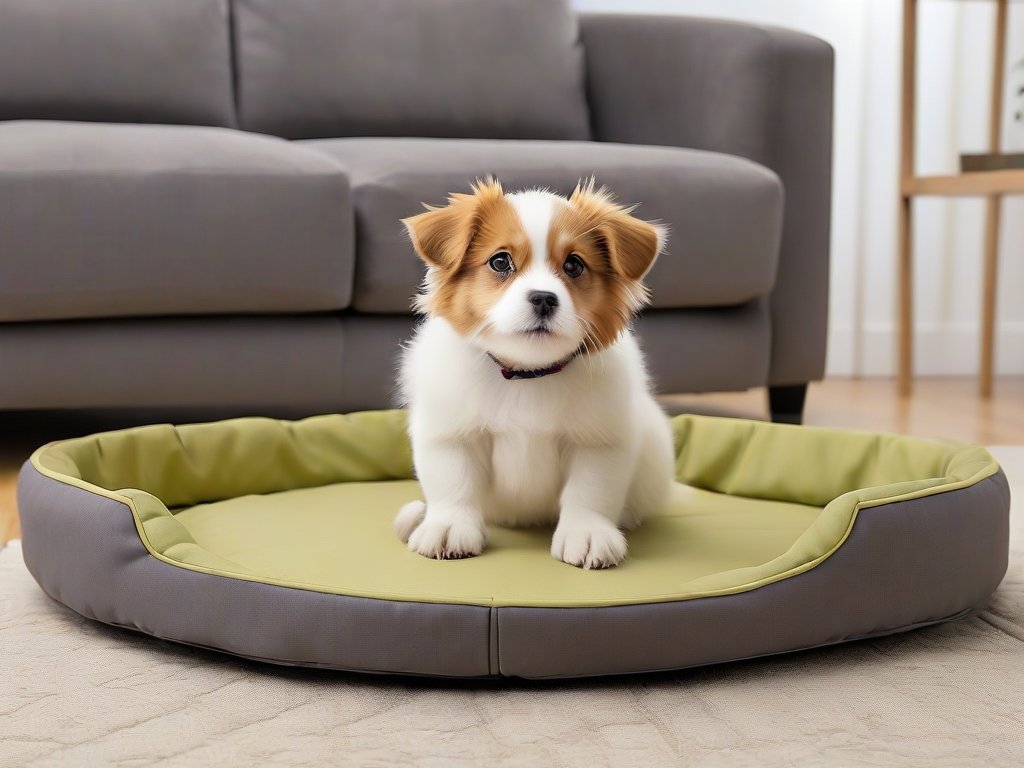It can be frustrating when your dog decides to pee on your bed. Understanding why this happens is key to solving the problem. Dogs may pee on your bed for several reasons, including marking their territory, a lack of house training, or even medical issues.
If your dog is a puppy or has recently been adopted, they might not have fully mastered bladder control yet. In some cases, dogs use urination as a way to claim their space, especially if they feel anxious or insecure. It’s essential to be aware of these reasons to help your furry friend and protect your bedding.
By addressing the root causes, you can help your dog learn better habits and keep your bed clean. With a little patience and the right training, you can change this behaviour and enjoy a peaceful night’s sleep once more.
Understanding Canine Communication
Dogs communicate in various ways, and understanding their behaviour can help you address issues like peeing on the bed. Two important aspects to consider are marking behaviour and the role of scent messages.
Marking Behaviour Explained
Marking is a natural behaviour for dogs. They do this to establish territory or communicate with other animals. When your dog pees on your bed, it might be trying to claim that space as their own.
- Unneutered males are often more prone to this behaviour, but females can also mark.
- This action can show comfort and security, as your bed holds your scent, making it feel like a safe space.
Additionally, stress or changes in routine can trigger marking. If your dog feels anxious, it may pee to relieve that stress, showing you it needs reassurance.
The Role of Scent Messages
Dogs have a highly developed sense of smell, and they use scents to communicate.
When they urinate, they leave scent messages that convey information about themselves. These messages can inform other dogs about:
- Identity
- Age
- Reproductive status
Your bed becomes a canvas for your dog’s “scent art.” By marking it, your dog is sharing important information with other dogs, even if there are none present.
Understanding these distinct forms of communication can help you interpret your dog’s actions better. This insight is key in addressing any issues, such as why they may pee on your bed.
Common Reasons for Bed Urination
Dogs may urinate on your bed for various reasons. These can be related to their behaviour or underlying health issues. Understanding the triggers can help you address the problem effectively.
Behavioural Triggers
Several behavioural factors can lead to your dog peeing on the bed.
- Territorial Marking: Dogs often use urine to mark their territory. If your dog feels the need to assert dominance or feel secure, they might choose your bed as a target.
- Anxiety and Stress: A nervous or frightened dog may seek comfort in your bed. Unfortunately, their anxiety could also lead to accidental urination.
- Lack of Training: If your dog is still learning to control their bladder, they may not wait to go outside. This can be more common in puppies or dogs that haven’t had proper house training.
- Attention-Seeking: Sometimes, dogs might urinate to gain your attention. This can happen if they feel ignored or if they associate urination with receiving a reaction from you.
Health-Related Causes
Health issues can also lead your dog to urinate on the bed.
- Urinary Tract Infections (UTIs): A UTI can cause your dog to have an urgent need to urinate. This discomfort might lead them to choose the bed as a spot to relieve themselves.
- Bladder Stones: Similar to UTIs, bladder stones can create pain during urination. This may push your dog to urinate where they feel safe, like your bed.
- Age-Related Issues: Older dogs may struggle with bladder control. Conditions such as cognitive dysfunction can also affect their behaviour.
- Hormonal Imbalances: Spayed or neutered dogs can occasionally experience hormonal changes that affect their ability to hold urine.
By recognising the reasons behind this behaviour, you can take the necessary steps to help your dog.
Medical Issues to Consider
If your dog is peeing on the bed, it might be linked to a medical issue. Understanding these conditions is important for addressing the problem effectively. Two common medical problems to consider are urinary tract infections and diabetes.
Urinary Tract Infections
Urinary tract infections (UTIs) are a frequent cause of inappropriate urination in dogs. If your dog has a UTI, they may have difficulty holding their urine, leading to accidents. Signs of a UTI include:
- Frequent urination
- Straining to urinate
- Blood in urine
- Licking their genital area
It’s essential to consult a vet if you notice these signs. They can perform tests to confirm a UTI and provide antibiotics for treatment. Addressing this issue promptly can help prevent further problems.
Diabetes and Other Conditions
Diabetes can also lead to increased urination. In diabetic dogs, high blood sugar levels cause the kidneys to work harder, resulting in more urine production. Other conditions that may lead to increased urination include:
- Cushing’s disease
- Kidney disease
- Liver problems
If you suspect your dog has diabetes or another condition, visit the vet for a check-up. They will perform blood tests and offer guidance on managing the condition and its symptoms. Identifying the underlying health issues is key to stopping those accidents.
Training Techniques to Prevent Unwanted Peeing
Consistency and positive training methods are key to stopping your dog from peeing on the bed. Establishing a solid routine and using positive reinforcement can help teach your dog where it’s appropriate to relieve itself.
Establishing a Routine
To effectively train your dog, set a regular schedule for potty breaks. Take your dog outside at specific times each day, such as:
- First thing in the morning
- After meals
- Before bedtime
When your dog knows when to expect bathroom breaks, they are less likely to have accidents. Be sure to immediately take your dog out if you notice signs they need to go. These signs can include sniffing around, circling, or whining.
Also, ensure your dog gets plenty of exercise. A tired dog is less likely to act out. If your dog is a puppy, avoid letting them access your bed until they are fully house trained.
Positive Reinforcement Strategies
Use positive reinforcement to encourage good behaviour. When your dog pees outside, praise them enthusiastically or give them a small treat right away. This will help them associate outside potty breaks with rewarding experiences.
Avoid punishment for accidents. Instead, clean up messes thoroughly to remove any lingering smells. Dogs may return to those spots if they smell their own urine.
You can also create a designated potty area outside. Lead your dog to this spot consistently. Reward them for going there, strengthening their understanding of where it’s acceptable to relieve themselves. Remember, patience is crucial; every dog learns at their own pace.
Managing Your Dog’s Environment
Creating a comfortable and safe space for your dog can greatly reduce accidents, including peeing on the bed. By focusing on the right materials and cleanliness, you can help your pet feel more secure and minimise unwanted behaviours.
Choosing the Right Bed Material
The bed material you choose can affect your dog’s comfort. Soft, absorbent fabrics can make it easier for them to feel relaxed. However, if your dog has a tendency to pee, consider using waterproof liners or beds made from materials that are easy to clean.
Look for beds with removable covers. This simplifies cleaning and helps keep the bed fresh. Avoid materials that trap odours or moisture, as this can encourage your dog to mark the bed again.
Ensure that the bed is located in a quiet, low-stress area. Dogs often seek comfort in familiar spots. Providing a space that feels safe can discourage them from peeing as a response to anxiety.
Keeping the Bed Clean
Regular cleaning is essential. Wash removable covers frequently in hot water to eliminate smells and bacteria. Use a pet-safe detergent to protect your dog’s health.
If accidents do occur, clean them up promptly. Use an enzymatic cleaner designed for pets to break down any lingering scents. This helps prevent your dog from returning to the same spot to pee again.
Consider using a protective bed cover. This helps guard against accidents and makes it easier to maintain a clean sleeping area. Rotate bedding regularly to ensure it stays fresh and inviting for your dog.
Creating a clean, comfortable environment plays a key role in preventing unwanted behaviours like peeing on the bed.
When to Seek Professional Help
If your dog frequently pees on your bed, it’s important to consider professional help. Understanding when to consult a veterinarian or an animal behaviourist can make a big difference in addressing the issue effectively.
Consulting a Veterinarian
If your dog starts peeing on your bed suddenly, a trip to the vet may be necessary. Medical issues can lead to this behaviour. Conditions such as urinary tract infections, bladder stones, or kidney problems can affect your dog’s ability to control their urine.
Key signs to watch for include:
- Frequent urination
- Urgency to go outside
- Signs of discomfort while urinating
During your visit, the vet may perform tests to rule out health problems. Getting a clean bill of health is essential before addressing behavioural concerns. If a medical issue is discovered, proper treatment can help.
Working with an Animal Behaviourist
If health issues are ruled out, consider working with an animal behaviourist. They specialise in understanding dog behaviour and can help pinpoint why your dog is peeing on the bed.
A behaviourist will assess various factors, including:
- Your dog’s training history
- Your home environment
- Any recent changes in routine
They may suggest positive reinforcement techniques to encourage good habits. Training sessions can help your dog learn when and where to relieve themselves. With the right guidance, you can set your dog up for success and reduce unwanted behaviours.
Long-Term Health and Behaviour Monitoring
Monitoring your dog’s health and behaviour is vital. Regular check-ups and keen observation can help you spot issues before they become serious. This proactive approach supports your pet’s well-being and can prevent unwanted behaviours, such as urinating on the bed.
Importance of Regular Check-Ups
Regular veterinary visits are essential for your dog’s health. Annual check-ups allow the vet to assess your dog’s physical condition and vaccinations. They can also recommend routine tests for urinary tract infections or other conditions.
Key Benefits:
- Early detection of health issues
- Updating vaccinations
- Discussing behavioural concerns
Don’t wait for symptoms to appear. Regular check-ups help maintain your dog’s health and can lead to behavioural changes that prevent accidents in the house.
Observing Behavioural Changes
It’s important to watch for any shifts in your dog’s behaviour. Changes such as increased urination or reluctance to go outside may indicate health problems. Keeping notes of your dog’s habits can be helpful.
Signs to Look For:
- Increase in accidents
- Changes in appetite
- Withdrawal from activities
If you notice anything unusual, discuss it with your vet. Addressing behavioural changes quickly can improve your dog’s quality of life and eliminate unwanted behaviours, like peeing on the bed.

